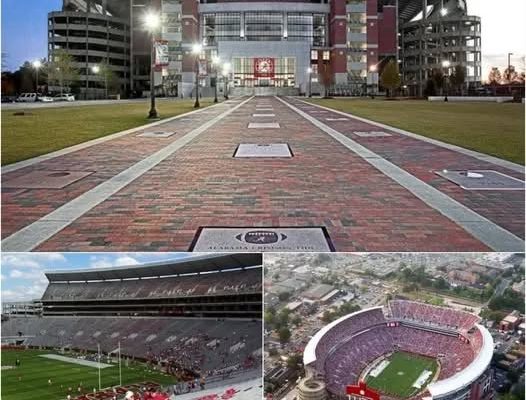The beating heart of college football is about to get even louder, even prouder, and far more imposing. In a move that is already sending shockwaves through the world of collegiate athletics, the University of Alabama has officially approved a staggering $175 million mega-expansion of Bryant-Denny Stadium, the legendary home of the Crimson Tide. The announcement, confirmed by university officials and met with raucous fan celebration, marks what many are calling the dawn of a new golden era for Alabama football and college sports at large. This isn’t just an upgrade—it’s a transformation. And make no mistake: Alabama is planting its flag with the clear message that it intends to remain the standard-bearer for college football dominance for generations to come.
For decades, Bryant-Denny Stadium has stood as one of the most iconic venues in American sports. Named after legendary coach Paul “Bear” Bryant and former university president George Denny, the stadium has witnessed some of the greatest moments in college football history. From championship-clinching drives to Heisman-worthy performances, it has been a sacred ground for Alabama fans and a house of horrors for visiting teams. But now, that legendary structure is about to receive the most ambitious facelift in its history—one that will dramatically reshape the stadium’s infrastructure, fan experience, and even its place in the pantheon of global sports arenas.
According to the approved architectural renderings and project plans, the $175 million expansion will encompass state-of-the-art seating additions, new premium suites, technology upgrades that rival NFL facilities, and a reimagined fan experience that blends luxury with legacy. The expansion is expected to increase the stadium’s capacity beyond 105,000, making it not only one of the largest stadiums in college football but also one of the most technologically advanced. Plans include a new 360-degree concourse, vastly improved concession areas, dynamic LED displays, a sound system overhaul, climate-controlled luxury suites, and even an immersive Crimson Tide museum experience built into the stadium’s footprint. The goal is simple but bold: make Bryant-Denny the cathedral of college football.
University President Dr. Stuart R. Bell emphasized the project’s cultural and economic significance in a statement released shortly after the approval. “This is more than bricks and steel. This is about investing in a legacy, investing in our students, our alumni, our fans, and the people of Alabama,” Bell said. “Bryant-Denny is a symbol of excellence, and this expansion ensures that it will continue to be the beating heart of our university and college football for decades to come.” Athletic Director Greg Byrne echoed that sentiment, calling it “a moment of pride and promise,” and noting that the stadium improvements will further secure Alabama’s standing as a national leader in athletic facilities, athlete support, and fan engagement.
The project’s funding is a masterclass in strategic planning. The university has secured a combination of private donations, premium seat license commitments, corporate sponsorships, and bonds to finance the expansion. Early reports indicate that nearly $100 million in private contributions have already been pledged, led by a passionate group of Alabama alumni and boosters who see the expansion as a generational investment. One such donor, who asked to remain anonymous, described the stadium as “our church on Saturdays,” adding, “When you walk into Bryant-Denny, you don’t just watch a game—you feel history. This expansion honors that history and propels us into the future.”
Perhaps most eye-opening is the technology Alabama plans to implement in the renovation. Stadium-wide 5G coverage, augmented reality fan apps, biometric ticket scanning, and interactive digital kiosks are just some of the features expected to modernize the fan experience. Plans also include the construction of a next-gen media and broadcast center within the stadium, which will serve as the new home for the SEC Network’s Game Day programming whenever it’s hosted in Tuscaloosa. In other words, Bryant-Denny won’t just be a stadium—it’ll be a broadcast nerve center for the entire sport.
Beyond the glitz and glamour, the project is also expected to have a profound economic impact on the region. With construction expected to create thousands of jobs, both short-term and long-term, local officials estimate that the expansion could generate over $300 million in economic activity for the state of Alabama. Hotels, restaurants, and retail businesses throughout Tuscaloosa are already gearing up for the boom, while tourism officials are predicting record-setting attendance for events in the years following the stadium’s completion. Already a mecca for football pilgrims from around the country, Tuscaloosa may soon become one of the premier sports tourism destinations in the South.
Construction is scheduled to begin immediately following the conclusion of the 2025 football season, with targeted completion set for the start of the 2027 campaign. University planners have promised minimal disruption during the interim seasons and have outlined contingency plans to preserve full-season home game schedules while the renovation is underway. Some seating areas may be temporarily closed, but the university assures fans that the spirit and energy of Bryant-Denny will be unbroken throughout the process.
The announcement has already sparked celebration across the Alabama fanbase and reignited national debates over the arms race in college athletics. In an age when NIL deals, transfer portals, and media rights dominate headlines, facility investments like this serve as a potent reminder that infrastructure still matters—and perhaps more than ever. Alabama’s move is likely to inspire other blueblood programs to revisit their own stadium strategies. Already, whispers are emerging from Columbus, Athens, and Ann Arbor about potential renovations in response. But Alabama was first, and as always, it did so with unmistakable swagger.
From a competitive standpoint, the expansion sends a crystal-clear message to recruits, players, and rival programs alike: the Crimson Tide are not just preserving their place at the top—they are building upon it. The new facilities will include upgraded locker rooms, enhanced training facilities, athlete recovery zones, and even custom film review theaters. For head coach Kalen DeBoer and his staff, the timing couldn’t be better. With the new coaching era underway following the legendary Nick Saban’s retirement, this expansion becomes an anchor—an unwavering vote of confidence in the future of Alabama football.
Fans and alumni have already begun rallying around the project, with social media exploding in excitement following the announcement. Hashtags like #BDS175 and #CathedralOfCollegeFootball trended nationally on X (formerly Twitter) within hours. Many fans are reminiscing about their favorite Bryant-Denny moments, sharing photos, and expressing awe at the designs and ambition of the project. Legendary alumni like Julio Jones, Derrick Henry, and Tua Tagovailoa have also voiced their support, with some even hinting at involvement in the project’s public campaign.
For opponents of Alabama, this development is likely both intimidating and exhausting. Just when it seemed possible for other programs to close the gap, the Crimson Tide have effectively widened it again. Facilities like the one Alabama is building will not only keep top recruits coming to Tuscaloosa, but will give them—and their families—an experience that feels more akin to the NFL than college. That is no small recruiting advantage. And in a time when brand matters as much as tradition, Alabama’s brand just gained another massive boost.
But for Crimson Tide fans, this moment is nothing short of historic. The expansion is not just a building project—it is a symbolic act of faith in what Alabama football represents: excellence, legacy, and an unwavering pursuit of greatness. In the words of one longtime season ticket holder, “We don’t rebuild—we reload. And now, we reimagine.” That reimagination is beginning with steel and concrete, but it’s fueled by decades of victories, unforgettable Saturdays, and a community that bleeds crimson.
As construction cranes prepare to rise over the Tuscaloosa skyline, a new chapter in college football is being written—one that begins with a $175 million promise and ends with a roaring crowd under the lights of a stadium fit for a dynasty. Alabama isn’t just building a stadium. It’s building the future. And that future, fittingly, will be written inside college football’s new cathedral.



